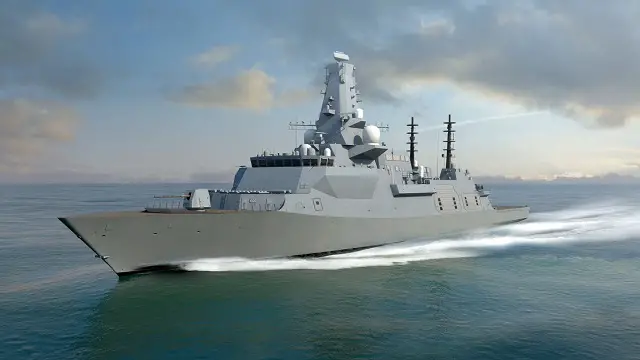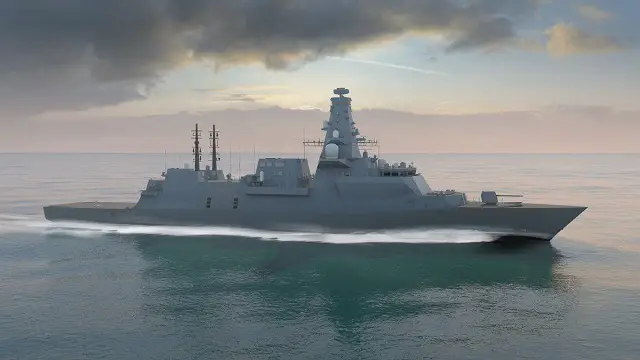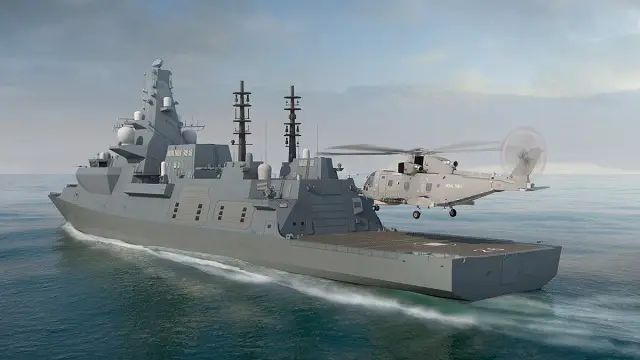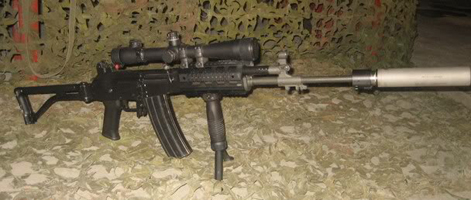
November 4, 2016
Type 31 Frigate – unwanted child of austerity or bright hope for a larger fleet?
It is widely accepted that the current total of 19 surface escorts falls far short of what is needed to meet the UK’s strategic aims. With the Type 26 frigate programme now fixed at 8 ships, the only way surface escort numbers are ever going to be increased is to build more of the cheaper Type 31 frigate (General Purpose Frigate – GPFF). The 2015 SDSR committed government to “at least 19” frigates and destroyers but on 4th November 2016, when talking in the context of frigates, the Defence Secretary said “We will have fleet larger than the fleet at the moment”. This is a positive sign and at least suggests intent in government build more than 5 Type 31 frigates.
Could exports and economies of scale put greater numbers within reach?
The recent devaluation of the pound by 20%, with speculation that its value will bottom out at $1.10 (meaning around a 30% devaluation) makes UK based shipbuilding considerably more competitive than even six months ago. The export potential of a Type 31 and even the Type 26, which until recently appeared very limited, may be more realistic in this new financial reality.
The Treasury-led development of a National Shipbuilding Strategy (NSS) begun in January 2016 and is primarily focussed on naval surface ship construction, is due to report before the Chancellor’s Autumn Statement on 23rd November. The NSS has a lot of ground to cover and the RN must hope it can offer more than George Osborne’s feeble 2015 plan to build one new warship every two years.
France has recently announced construction of its new 4,200 tonne FTI frigate at an estimated cost of £690 million per ship, and shipbuilder DTMI estimates there is market potential for at least 40 such frigates. If government wants a thriving warship building sector, investing a little more in making the Type 31 a more powerful flexible design at a better price point than the FTI offering could reap dividends. UK warship exports lag way behind France and Spain and there is much work to be done to get back into this important market. If government is able to commit to more than the bare minimum 5 ships for the RN, this could leverage economies of scale and increase confidence from potential foreign buyers.
25 escorts, a realistic target ?
The RN manpower crisis may have stabilised by the late 2020s but the lower manning requirements of the Type 26 and Type 31 will be very welcome. The Type 23s and 45s fleet combined needs around 3,550 but the overall requirement should fall by about 1,000 to around 2,550 or allow more vessels to be manned. A younger fleet should be able to offer a slightly higher level of availability.
The 2008 defence review suggested that 30 surface escorts were needed to meet the RN’s operational requirement. Commitments and threats have in no way reduced since 2008.
To escort the operational aircraft carrier and maintain the existing global commitments appears to require, at the very least 10 surface escorts deployed at any one time. Assuming that these units can achieve 40% availability, this suggests a surface fleet of 25 frigates and destroyers. This would require buying 11 Type 31s. In the current climate where the Type 26 construction is not set to start before summer 2017 and the Type 31 exists only on paper, this may seem fanciful. There is some hope that attractive industrial and export benefits with UK-wide construction could just tempt the Treasury to properly back the programme. Currently the future frigate budget is set around £8Bn. If the 8 Type 26 cost around £750M each, as it stands the 5 ‘planned’ Type 31 can have a maximum unit cost around £400M. Adding another 5 or 6 ships to what is already in the funding plan might cost something like £200m per year. This would seem a small price to pay when this could help re-balance the capability of the surface fleet and sustain several shipbuilders for a decade or more.
It seems quite likely the Type 31 will be built by a consortium (similar to the Aircraft Carrier Alliance) led by BAE Systems, but with work shared around UK shipyards. The NSS should shed more light on this but such an arrangement helps spread the economic benefits around the UK and beyond the Clyde which will be largely occupied with Type 26 work.
Can the Type 31 project deliver a credible frigate?
As we touched on in a previous article the Type 31 concept is attempting something extremely challenging. Within a constrained budget and relatively tight timeframe, industry must deliver a frigate that will be an effective platform into the 2030s and 2040s. As an example to avoid, work on the Type 26 will begin two decades after the project to replace the type 23 then called the “Future Escort” was announced in 1997. The 10-year design to delivery schedule will require very tight discipline by the customer in not moving the goalposts during the project and the contractor to deliver on time and on cost. This is possible but will be in contrast to the problems of most large UK defence procurement projects in the last 30 years.
The Type 31 will emerge into a world of new and challenging threats to surface ships. Hypersonic missiles, lasers, weaponised unmanned vehicles and super-quiet conventional submarines are all proliferating. In a high-intensity future conflict, even the Type 26 may have its hands full, will the less sophisticated Type 31 cope?
In terms of design, the basic Type 31 model must be a capable patrol and general purpose frigate, suitably equipped to undertake independent deployment, but also capable of stepping up to act as carrier or amphibious escort if needed. The main cost savings over Type 26 must be found in its smaller size, lighter armament, reduced survivability and more basic propulsion.
If the Type 31 is going to perform as a useful escort then it needs more than self-defence weapons. Like the Type 26, it will still need good sensors, command systems and some self-protection. Assuming Sea Ceptor is fitted then it can provide and basic air defence umbrella over a few ships. Growing underwater threats demands the RN have more anti-submarine platforms. The Type 26 will undoubtedly be a fine submarine hunter but the Type 31 must also be a deterrent to submarines if it is to be considered of real use as an escort. One of the big cost-drivers for the Type 26 are the noise-hygiene measures to reduce the self-radiated noise that impairs passive detection of submarines. The Type 31 will inevitably have nosier propulsion. Perhaps operating a few of its own unmanned underwater vehicles (UUVs) as sensor platforms could be an answer to the Type 31’s need for effective anti-submarine capability on the cheap. The Thales CAPTAS-4 compact offers very small footprint towed array sonar that should also be a minimum requirement for the Type 31. Fitting of anti-ship or land-attack weapons will probably have to take a lower priority.
At around £1Bn each the Type 45 and the Type 26 can almost be considered ‘capital ships’, with which few risks can be taken. A cheaper, more ‘expendable’ ship offers important flexibility on operations. During the Falklands war, lacking available minesweepers, it was the cheap Type 21 frigate HMS Alacrity that that was the sacrificial lamb tasked to sail through Falkland Sound to see if there were any mines. (Fortunately there were none and she survived unscathed).
In conclusion
The Type 31 remains controversial, one respected defence commentator has even called it “the pointless class”. The specification is still very fluid, even within the navy apparently “everyone within NCHQ has a different view”. Ultimately the design will have to be evolved fast and an off the shelf solution seems to be the most realistic way forward. The main image above shows the BMT Venator-110, probably the best baseline option of the 3 outline design proposals for the Type 31 in the public domain at the time of writing. We will examine these proposals in a subsequent article.
What is certain is that the importance of decisions on the Type 31 programme should not be underplayed or seen as of secondary importance to the Type 26 programme. A well designed Type 31 frigate has the potential to maximise the potency of the fleet whilst rejuvenating warship building in the UK. But a leap of faith is needed to choose the right design, and then follow through and build in sufficient quantity to ensure economies of scale.
http://www.savetheroyalnavy.org/type-31 ... ger-fleet/












